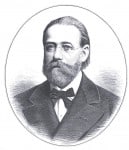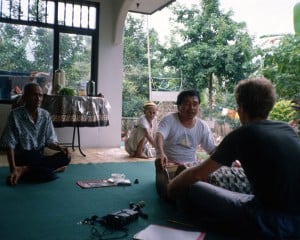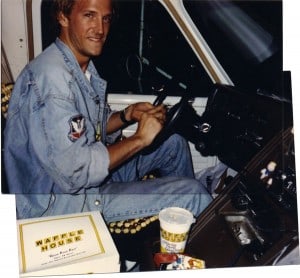A Man About A Horse–ECM bio pt. 1
Pt. 1: This Album
(Pt. 2: Electric Guitar in Madison)
Wasps
Two years ago I was working with a couple of friends I had hired to fix up my house. I used my friend Paul's enormous ladder to get up to the gutters to clean them out. My job was to use the dandelion removal tool to flip the decaying leaf-goo-matter out of the gutters. I was up on the ladder, very high. I was up as high as Paul, who was on the other side fitting screens in the gutters I had cleaned.
There was a complication in this simple task of mine because I had to clean the gutters up to about ten feet away from an enormous wasp's nest. It was hanging 20 feet over the front door to our house. Paul's advice was to blow up the wasps' nest, but I, being a left-wing atheist-vegetarian militant-pacifist nixed that plan. It was a beautiful piece of work this nest, yes it was. The nest was a bulbous, conical, gray swirl of grain. Bit by bit, by bite, these wasps had gone deep into the woods collecting bark and pulp, chewing all the way home, spitting it out in a pattern, just so. What a thing, a frozen tornado of potential pain. Immobilized wasp spit. Just waiting. They were very quiet while I was up there, just a little business going on, one or two coming or going. I felt we had an understanding, an agreement, the wasps and I. ("Wasps, you hang your pulpy sculpture twenty feet over my front door, leave me alone way up here on this ladder, and I will protect you from Paul, who wants to blow you up.") There was still menace, in spite of our treaty. I was aware that there was stinging fury just one wrong move away. But I was ready for it, I was dressed up. I was up on the ladder, not intending to get any closer than ten feet from these creatures, and dressed for the part. I had wool pants, long underwear, a winter jacket, a balaclava over my head, goggles and gloves.
The fatal error was the gloves. It was a hot day. I chose my wife's driving gloves out of the box of winter accessories. Very thin material. (How would the wasps know, anyway?) I'm up there, flipping the gelatinous goop out of the gutters. It was very hot with all that stuff on. It must have been 90 degrees. In looking back I can't figure out what I could have possibly done wrong. I was always ten or fifteen feet away from the little wasp apartment. But something I did made the wrathful wasp sentinels decide it was time to attack. I looked over just in time to see the beginnings of the sortie--it was lovely, liquid, and slow-motion, just like a car crash I was in once. The nest stayed attached exactly where it had been, but it appeared as though an invisible hand had tipped it so that the wasps could pour out like cereal out of a cereal box. They ladled themselves out, dropped down about half a foot, and then adjusted to curve up and head over for me, the guy on the ladder. It was an unbroken line, out the spout, down, adjust, and beeline to Steve. Well, I was ready. I saw the attack formation. I was aware, cool, calm. I started to back down the ladder.
Some great power, God maybe, informed the wasps that the ladder guy was wearing very thin driving gloves, and it was possible to clump up on his hands and sting through them. Jesus or Yaweh or somebody had also informed wasp consciousness that it was possible to squeeze under the goggles and sting around the eyes. At that point I lost it. I was only about five feet from the ground and safety, but I let go, pitched backwards, put my hand out and fell. I hit the ground, my right hand leading the way. Bang. I tore off my now-useless wasp outfit, ran inside, and put ice on my face and hand, not aware of my broken wrist bone. Unaware for a few months, actually.
Later that evening we played softball. Paul arrived early at the softball diamond ahead of me, told the story, and as I walked up to bat Julian called out, "Maybe we'll see a little sting in your bat tonight." No such luck, in fact, I was told later by Mr. Bone Doctor that if the injury had been a simple hairline fracture at that point it was probably a complete split after a couple of fruitless swings of the bat. I was 0-for-3 that night. There was surely no sting in my bat.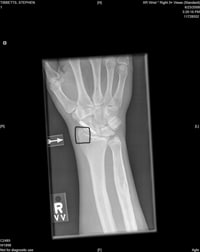
Plan
A year passes by and it's time to do something about the broken wrist bone. Bone-Doctor-man tells me that as surely as the sky is blue I will get wrist arthritis unless this bone is grafted, pinned and screwed back together. Having no medical insurance I have to wait until after a 40 city tour with Choying Drolma and a group of Tibetan nuns to afford this. Strangely, I felt a lot of flexibility and hand freedom in playing guitar on that road trip. I made a plan. They are planning to slice my wrist open, pin the skin back like a frog in biology class, and drill, screw, and suture things together with bone shavings "harvested" (their word) from my hip. I would be on ice (as far as guitar playing) for six to eight weeks. So I made a plan.
First I would spend about a week laying down some blazing hot drum tracks. I would use the samples and patterns I had from my drum studies in Bali (from 1991). Then I would set up my Marshall guitar amp in the bathroom of my studio (because it's so loud) and run lines to the Matchless and the Pod (guitar amps) and play berserk electric guitar for two nights. "Berserk" because you never know how these surgeries go. Two people died last year in Minnesota from routine knee surgery. I could wake up dead, or without on arm, or with a stump. ("Sorry Steve, 'complications.'") That should inspire my playing a bit. (Your last chance!) After surgery, I would go into retreat for a month at a place I know in southern Colorado and be very still for a month. I would not fall on my arm and re-break it like I did in 1974. I would be ready for the itchiness that comes from wearing a cast. I would bring a 12-inch screwdriver that I could work up and into the cast to scratch my arm. (...ahhh.) I would come back after four weeks and be miraculously healed, four weeks to a brand-new wrist instead of the projected six weeks.
So that's what I did, except I only ended up with one evening for the berserk/inspired guitar tracks. But they were good, and I used them. There are lots of mistakes, pratfalls, and sloppiness. Much of the guitar on this album is from that night. It's sliced, diced, turned inside-out and backwards, and often left as-is. As-was. I had a complete recovery from the accident. My wrist and hand are fine now.
Imagery
Every piece in this new album is rich in color and landscape. There's a plot, intention and meaning. Do I want anybody to know the specifics of plot, intention, and meaning? Definitely not. Why not? I'll tell you why not. In 1973 I took a very nice music appreciation class at college. Harry Hammer, our soon-to-be-deceased instructor led us through his favorite classical music. It was very pleasant, especially at 9 in the morning. Our assignment one Friday was to listen to Smetana's "Moldau" and tell him what we thought it was about the following Monday.
I spent a good part of that weekend prone on the carpet in my dorm room, staring at the ceiling, listening. Sometimes I listened with Sharzhad Karimi, an Iranian woman from our class I had a raging crush on. Sometimes I listened alone. It was a fine weekend, and the music filled my mind with all sorts of strange and wonderful imagery. It reminded me of the times I spent listening to "Revolver" and "After Bathing At Baxters" as a 14-year old. I would come home from school and put on one of those records and recline with my head between the speakers. The imagery that unfolded is still tied to the music, to this day. So it was disappointing to hear Harry's lecture that Monday about Smetana's visual program for the music. The wind instruments that start the piece symbolize a cold stream and a warm stream that eventually combine, form the Moldau, and finally parade through Prague. Getting that information completely destroyed my own imagery, which had involved a desert, an Iranian princess, myself as a centaur, and so on. 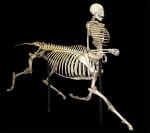 I think it's better not to know about the programmatic intentions of musicians and composers. I'm so grateful that the Beatles never made a video to go with "Tomorrow Never Knows." Until my dying day I will have the strange vision of a raft and a river of barking puppies whenever I hear that song.
I think it's better not to know about the programmatic intentions of musicians and composers. I'm so grateful that the Beatles never made a video to go with "Tomorrow Never Knows." Until my dying day I will have the strange vision of a raft and a river of barking puppies whenever I hear that song.
This Album
This album is ripe for another version of the review that I had in the San Francisco Examiner for "The Fall of Us All." It said something like, "The good news about the new Steve Tibbetts record is that it sounds like...a Steve Tibbetts record!" It's very dense and very layered. There are lots of things in there that hover just under or just over the threshold of audio discrimination. Voices, clapping and more; it's folded in and peeking out.
I made my own sample library. I work for study abroad programs in north and south Asia occasionally. On one of my last evenings in Ubud (in Bali) I dragged the student gamelan set into my room and sampled it, note by note. It was a hot night, so I left the doors and shutters to my room open. There was a rice paddy right outside my window, and lots of bugs, frogs, and twittery things ended up on the samples. It lends a nice, living high end to the sounds. The big drum patterns were learned from studying in Indonesia. My drum teacher took me to his friend's gong shop the day they were doing a bronze pour. We watched them pour molten bronze into the forms. Afterwards, because his shop was closed for the pour, he let me sample all the gongs in his shop. Some of the samples include the sound of his chicken, who wouldn't stop screeching.
Voices
I spent three weeks studying at a retreat center in Vermont. There were about 250 people there. All would read through a particular text out loud before studying it, in this case, the Hevajra Tantra. After about 10 days of this I noticed that people were unconsciously arranging themselves into sort of a chorus. By the second week it was like a symphony of voices: the Vienna Tantric Choir. The men and women would be split an octave, as is usually the case in groups, but people began to find the 5th, the 4th, and even the 2nds and 9ths. Someone would pick up the 6th, and others follow. Some would move between pitches, more and more confidently, unconsciously confident. I taped some of it. In my studio I took the words and layered them in with the percussion and guitars. I tried moving the voices in and out of focus so that some words were audible and others were not. Eventually I mixed them so that they would fold in with the high end swish of the cymbals and the attack of the percussion. Synthesesia: seeing sound, hearing colors. The voices roll along the top of the cymbals, hide in the shakers, and whisper along with the gongs. I like playing with the imagery that music forms in consciousness. The voices are like something you are trying to remember but can't quite.
Marc's Drumming
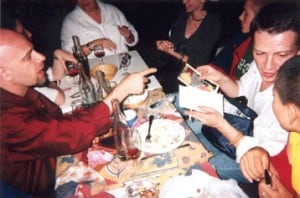
Marc tries out his French in Lyon
A lot of the drumming is mine, but I had Marc double many drum patterns to cover up my lack of technique and to put some air around electronic drum sounds. After that I asked him to bring his favorite instruments to the studio and we set up one, all-purpose Marc-instrument for him to play. He brought a few cymbals, jingly things, a kick drum he'd found in a dumpster, springs, and lots of percussion toys. I set up two microphones to give him a nice stereo soundstage and rolled tape. I made an effort to confuse Marc by occasionally playing with the reels on the tape machine as they rolled. I'd speed things up or slow the tape down. Marc rose to it, and played beautifully. There's a lot of his talking in there, simply because his first takes were the best ones. Marc starts out playing with great vigour 20 seconds into "Lochana" and as I leapt to the faders he shouted, "Never mind my distortion. You will learn to live with it." Wendy, who stopped by later to listen said, "That's what I tell my husband."
Guitar Setup
I've set up my guitar to play diatonic masses of instruments and sounds I've sampled over the years. Each string triggers a different midi channel, and each midi channel has a scale that doesn't necessarily correspond to the notes I'm playing. Playing an E note on the b-string might trigger an C gong, an A jublang, and so on. You can hear that most clearly at the end of "Red Temple." The 6-string acoustic guitar I played triggered gong samples in real time.
Recording and Mixing
I used my old analog 16-track for a lot of the tracks, and dubbed some things to Digital Performer, a computer music program. I had the time to mix it and mix it some more, due to the flexibility of the computer program. There's a trade-off in doing that. I got the beautiful and detailed mix I wanted, but there was none of the tension, release, and surprise that comes from the old way of mixing. The old way: you would set up the mixing console, stick little notes and markers everywhere, get ready, and go for it. When you get a good mix that way there are mistakes, but it has a wild and fresh feeling. The mix is part of the performance.
I tried to mix with a reference, as I always do. A stereo reference test. Year ago Marc and I set up a turntable and performed A/B tests between "Physical Graffiti" and our in-progress mix of "Exploded View" just for fun. We hauled in two huge JBL speakers we called the "butts" because the tweeter was set deep in the speaker with two ass-like curves coming out, dispersing the sound. It was an enjoyable mix, and it worked out well. This time I used "Lateralus" by Tool and "Solid Ether" by Molvaer (on ECM, actually) as references. I like the sound of both of those CDs. But I couldn't seem to get the EQ right on this one. On most CDs these days the high end is incredibly bright and the overall level (especially on the Tool CD) is extremely compressed. I'd switch back and forth between the CDs and the mix, Tool/Horse, Ether/Horse/Tool/Horse, and it always sounded like mine was swaddled in muslin. What to do? The shroud of Turin, I couldn't get it off the speakers! I tried a lot of things, but all of them just seemed to make the music sound brassy and coarse. Not right. I called Lee Townsend, an old friend and ex-ECM worker and asked him what he did. Did he work to make his mixes sound real bright? He said, "Don't fall for that--don't crank up the treble." So I left it mostly as it was. I left it for the mastering engineer to sort out.
I'd Change
What would I change? I wish I had not been so fascinated with the cut-and-paste compositional possibilities of the computer program. Sometimes the music became more of a technical and visual challenge that an audial one. I was seduced by the process. I wish I had spent more time in basic appraisal of the composition before I went deep into the overdubbing and mixing. Sometimes elements that might not fit together naturally were welded to each other. A donkey's head on a cow. A cat in a dog suit. Deer with claws. (The mix is very cool.)
Cover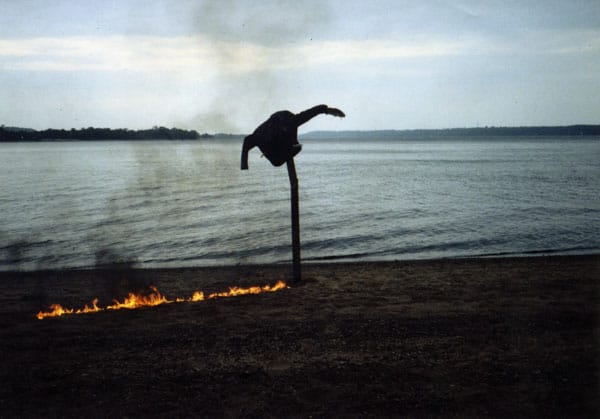
I had a brown leather jacket that I had bought when I was 16. I got it at Berman Buckskin in downtown Madison for $75. I wore it as an accessory to my underpowered Honda 175 motorcycle. I wore it on the road, to Europe, and all over Asia. I wore it on the back cover of "Northern Song." After 30 years it was starting to rot to pieces and had to be retired. Throwing it in the garbage seemed a little heartless. I took it to a friend's cabin on the St. Croix River, crucified it on two wooden beams, filled the pockets with fireworks, doused it with gasoline, set it on fire, and photographed its immolation. The next photos on the strip of negatives were taken in Thailand, so I must have gone to Asia soon after that (without my jacket). I saved the zipper, though.
Booklet
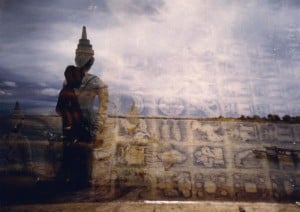 In my first trip to Nepal I took about 10 rolls of slide film and accidentally ran 5 of the rolls through the camera twice. They were the best slides. Multiple images were layered in the same picture. It was more evocative of travel memories than a simple picture. Layers upon layers of meaningless and meaningful juxtapositions. From then on whenever I traveled I would often run the film through the camera twice. The photograph with the temples and clouds is a double exposure from Bagan, in Burma. It has the shape of Minnesota, sort of. Another photo is of the Irawaddy River and a boat. Waiting for a boat.
In my first trip to Nepal I took about 10 rolls of slide film and accidentally ran 5 of the rolls through the camera twice. They were the best slides. Multiple images were layered in the same picture. It was more evocative of travel memories than a simple picture. Layers upon layers of meaningless and meaningful juxtapositions. From then on whenever I traveled I would often run the film through the camera twice. The photograph with the temples and clouds is a double exposure from Bagan, in Burma. It has the shape of Minnesota, sort of. Another photo is of the Irawaddy River and a boat. Waiting for a boat.
Marc Anderson
I've worked with Marc for a long time. A friend called me up one evening in 1977 and said, "You have to come see this guy play congas." We went, five of us, to the North Star Ballroom at the University of Minnesota where his band ("Clear") was playing, to about twenty people. Marc was playing like he was possessed. Voodoo-boy. I knew he would be good in the studio. Marc is now the number one call for percussion in the Twin Cities and will be ordained next year sometime as a Zen Priest in the Soto order. (True!) Marc has played with Taj Mahal, Prince, Robert Fripp, and David Sylvian, among others.
Jim Anton
Jim Anton is the number one call in town for bass. Jim is a big guy, and can shave any design he wants out of his beard, since it is so all-pervasive and fast growing. For that reason he can be scary looking if he wants to. That's good to have on the road, but not when crossing the Canadian border late at night, coming home to Minnesota. Jim has played with Jonny Lang, the Rembrants, Shannon Curfman, and many others.
Marcus Wise
Marcus Wise works each summer as a mason; tuck-pointing chimneys. He saves enough money to spend the entire winter playing tabla. He tours about four months of the year with Coleman Barks and Robert Bly, accompanying their spoken word performances. He's played with, among others, Sultan Khan, Zakir Hussain, and members of the Grateful Dead and the Doors. Marcus is tenacious. He calls me up and says, "Let's play, I'm coming over." I'm never too sure if I want to do this, until he gets here and we start playing. He plays fast, and so do I. It's fun. Faster! Faster! "Let's try something in 9, but fast." He brings a six-pack of Moosehead beer, and drinks four of them. After two beers he says, "Hey, let's record something." That's how those two pieces got on the CD. Out of 50 hours of recording we had two things that really worked. Finally, after four beers he gets up, goes to the toilet and urinates loudly, leaving the door open. He'll shout out something like "You know why I like Moosehead?" I say, "No, why do you like Moosehead, Marcus?" He says, "Because you can just PISS IT RIGHT OUT." Wow. Talk about pleasure. Now my wife, whenever we go out says, "You know why I like Moosehead?"
Touring
"Will you tour?" Maybe, maybe not. We've done enough late-night hell-bound drives in Ford Econoline vans. Too much driving through the night to gigs in college grills. I remember Marc (from the stage) asking the four people who came to see us at the "Ahoy Lounge" at the University of California Irvine if they would help us load out. They all helped. I remember a college grill in Tennessee where, when the someone in the kitchen would yell, "Toaster!" I would know that my side of stage was about to go dark, along with my amp. I remember too many gigs where, after setting up and going out for something to eat, we'd come back to the venue to see far too many parking spaces. Plenty of free parking. Or we'd load in and the promoter would have set up the floor "cabaret style"--meaning: few advance ticket sales, so they'd set up round tables, chairs, and put those nice candles on the tables: the ones in the red glass holders with the white plastic mesh around them. Very stylish. I remember a particularly tough drive from L.A. to Winnipeg, climaxing with the confiscation of our truck on the way home by the US Customs Service. Our sound guy had left his pinch-hitter on the dashboard. Oops.
I remember one drive in particular, a long one. Salt Lake City to Portland. We had a bed set up in the back of the Ryder truck we'd rented. Sort of a bed. Cody (Marc's brother and our sound guy) would pack the truck after the gig so that the soundboard road case was closest to the cab of the truck. Then we'd put sleeping bags down on it. The only possible problem would be that if the driver had to make a sudden, emergency stop the bass cabinets and mid-bins would fall on the sleeping musician. So sleep was not so restful. We decided to drive through the night and sleep for a few hours at a motel outside of Portland. I took the first shift. Drive drive drive. Sometime around 3AM Marc came up to the front of the truck. He poked his head in, then plopped in the passenger seat. He was all mussed up and sleepy looking. He said, "Cody and I were curled up on the soundboard like little mice." Marc thought for awhile. Drive drive drive. He said, "I bet Keith Jarrett and Jack DeJohnette have never curled up on a soundboard like little mice." He was probably right.
We talked about the gig. Drive drive drive. He said, "Steve, I like playing music with you, and going on the road with you, and loading in and loading out with you, but I don't like looking out at the first three rows of people and seeing three rows of versions of you." I looked out at the crowd the next few gigs, and he was right. But these fine people are kind enough to help us load out.

